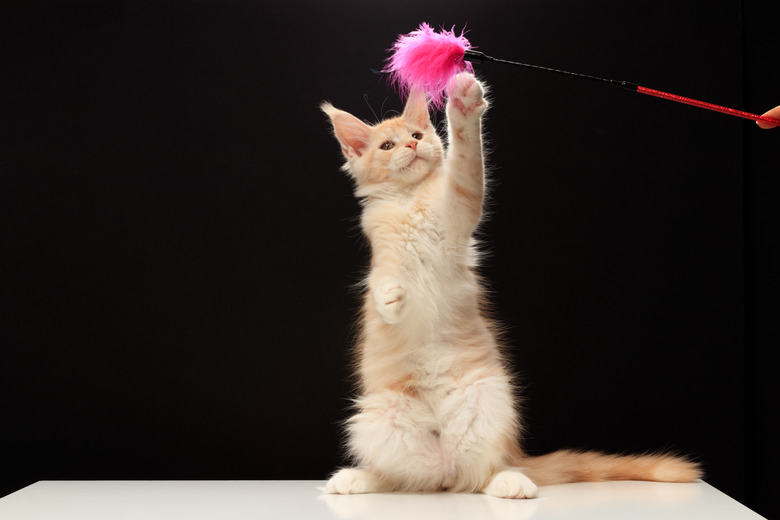Can Cats & Dogs See In Ultraviolet?
Can cats and dogs see things that humans can't see? We're not talking about supernatural things, although if your dog is staring at the wall you might be tempted to think he's looking at spirits or ghosts. Color vision is not the same for all animals, humans included. And ultraviolet light is a type of light on the spectrum that many animals can see. Research has uncovered most of the ways in which we believe cats and dogs see.
What is ultraviolet light?
What is ultraviolet light?
Visible light comes in a spectrum of colors. Think about the colors that you can see in a rainbow . . . red, orange, yellow, green, blue, indigo, and violet. Those are the components that make up the "white" light that we can normally see. Visible light actually occupies a fairly small range on the spectrum of colors.
Light waves have wavelengths of different lengths, from shorter to longer. In our eyes, each different wavelength of light is transmitted to our brain as a different nerve signal, which we perceive as a different color. Red light is on the longer end (toward the left) of the spectrum of colors with a wavelength of around 700 nm long. Blue and purple (violet) light have shorter waves and are on the right of the spectrum, with wavelengths of around 400 nm.
The name "ultraviolet" provides a clue for the type of light this is: If you continued to the right past the shorter violet light, the wavelengths would become even shorter, and become "ultraviolet." Likewise, shorter light wavelengths further to the left of the red range become known as "infrared." The structure of human eyes gathers and transmits light that we perceive as color. It's this structure that determine why we can't see ultraviolet light, and why dogs and cats (and other animals) can.
Human eyes
Human eyes
Human eyes have a lens over our eye that blocks most ultraviolet light, meaning we just can't see that range of light at all. Human eyes also have three types of specialized cells called rods and cones which detect different wavelengths of light. Dogs, though have only two type of cones, which means their vision is close to what humans call being colorblind. Cats also have three photoreceptors, but can't see the richness of colors that humans can.
Cat and dog eyes
Cat and dog eyes
Cat and dog eyes have a lens also, but that lens passes through some ultraviolet light so that it reaches the retina. The lens may be an evolutionary protection that prevents eye damage that would be likely to occur with constant exposure to the higher energy wavelengths of ultraviolet light (which is why we wear sunglasses).
There's is growing evidence that dogs and cats can see into the ultraviolet range. A 2014 study published by the Royal Society showed the results of a study looking at the eye structure of 38 species of mammals, including dogs, cats, rats, reindeer, ferrets, pigs, hedgehogs and many others, to look at how much UV light reaches the retina. The scientists found that many of the species, including dogs and cats, did allow a good deal of ultraviolet light into their eyes.
They found that in the dog's eye, 61.3 percent of the UV light reaches the retina. Cats allowed for nearly as much: 58.9 percent of light reaches the retina. Rodents, by contrast, allowed 80 percent of light to reach the retina. The theory is that the UV light sensitivity allows rats to follow the urine trails of other rats. How pleasant a thought! It also probably explains how polar bears and other arctic animals are able to effectively hunt other white-furred animals in a snowy landscape.
Other animal eyes
Other animal eyes
It's quite common in the animal world to be able to see ultraviolet light. In fact, humans are at a disadvantage in not being able to see more. Our world would look a whole lot more colorful if we could.
Not long ago, scientists discovered a type of butterfly with 15 photoreceptors, the highest number ever reported in a single insect eye. Underwater shrimp have been reported to have 16 photoreceptors. Insects and birds that visit flowers typically have a greater number of photoreceptors which allow them to see flower structures that we can't For instance, a flower that looks plain yellow to human eyes could be shown to have different colors on its petals and a dark center, which could guide the pollinators to the best spot for them to find the nectar.
Conclusion
Conclusion
While there's no way that we can be sure exactly what dogs and cats see, this research gives us a pretty good understanding that yes, dogs and cats can see in the ultraviolet range, at least a little. As with human eyes, there is a variety of lens shapes and photoreceptor cell shapes which affect the nerve signal that reaches the brain — a t-shirt could be perceived as "blue" to one person and "green" to another. Yet another person, with a wider range of color perception, may swear it's "turquoise."
So while the 2014 study found that dogs and cats can see around 60 percent of the ultraviolet light in their environment, individual dogs and cats may have more or less ability. Why would it be important to have this ability? If it makes urine visible, that could be a large part of what is driving your dog's wandering nature when you go out for walks. For cats, it may make prey such as mice easier to follow.
Always check with your veterinarian before changing your pet's diet, medication, or physical activity routines. This information is not a substitute for a vet's opinion.
References
- University Corporation for Academic Research: Visible Light
- Palm Beach State: Anatomy and Physiology
- McGill Office for Science and Society: Are Cats and Dogs Colourblind?
- All About Vision: UV and Sunglasses – How To Protect Your Eyes
- The Royal Society: The Spectral Transmission of Ocular Media Suggests Ultraviolet Sensitivity Is Widespread Among Mammals
- Frontiers in Ecology and Evolution: Extreme Spectral Richness in the Eye of the Common Bluebottle Butterfly, Graphium arpedon
- Cosmos: The Incredible – And Bizarre – Spectrum of Animal Colour Vision




